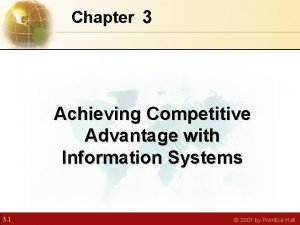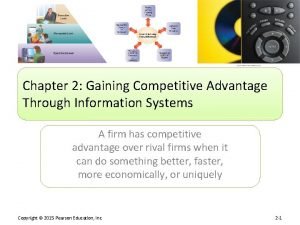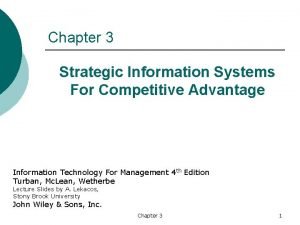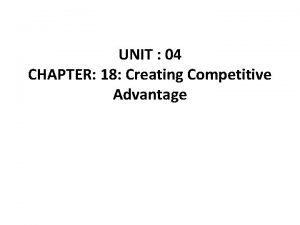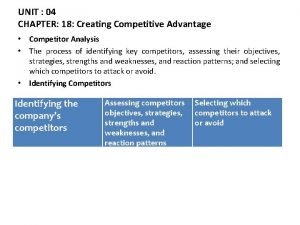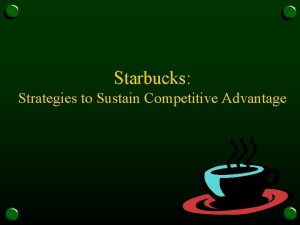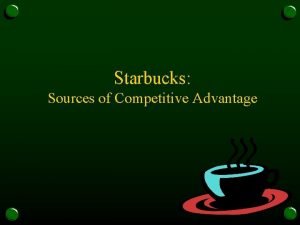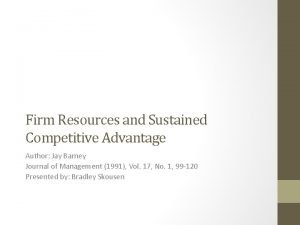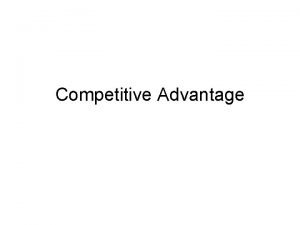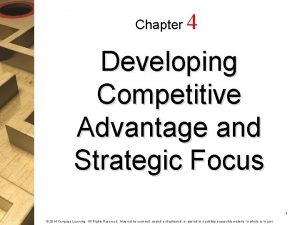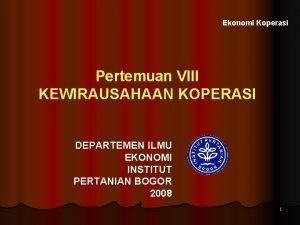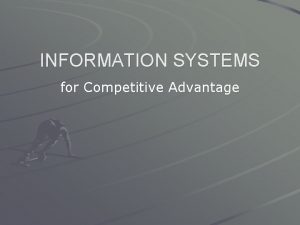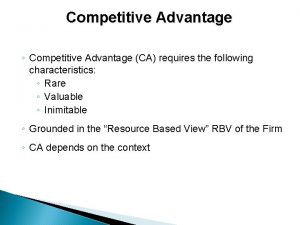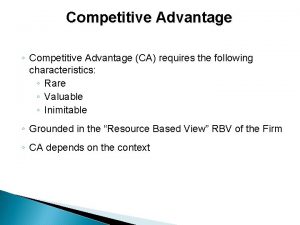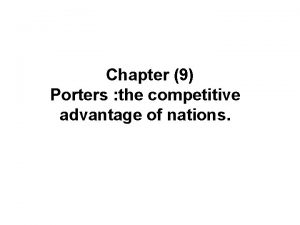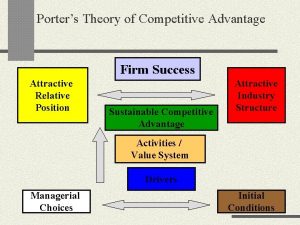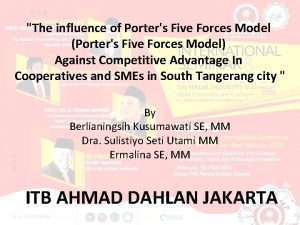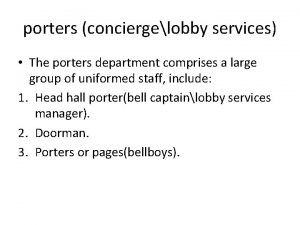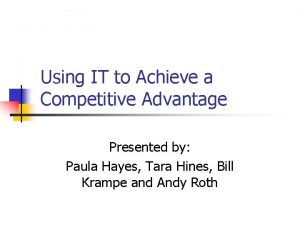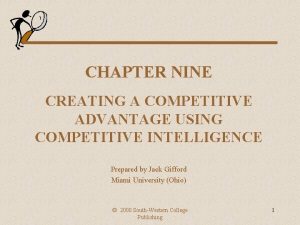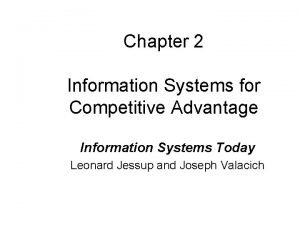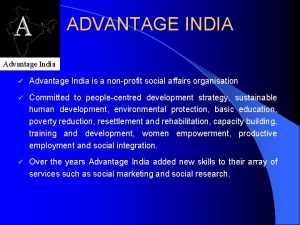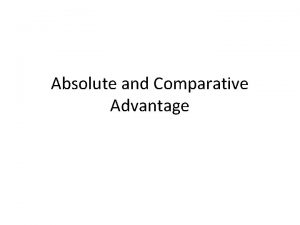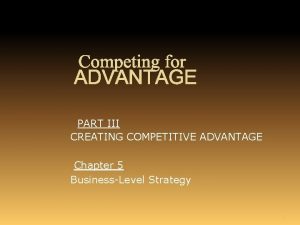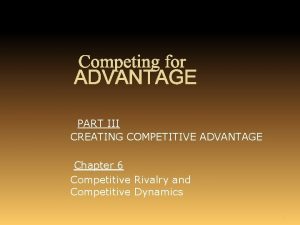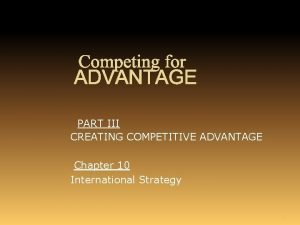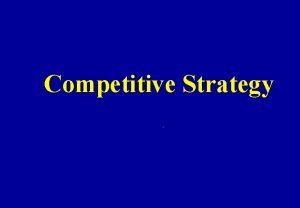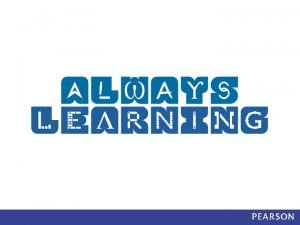Using Information Systems to Achieve Competitive Advantage Porters

























- Slides: 25

Using Information Systems to Achieve Competitive Advantage Porter’s Competitive Forces Model • One way to understand competitive advantage • Five competitive forces shape fate of firm 1. Traditional competitors • Competitors in market space continuously devise new products, new efficiencies, switching costs. 2. New market entrants • • Some industries have low barriers to entry: • E. g. , food industry versus microchip industry Newer companies may have advantages: • Newer equipment, younger workforce, and so on.

Using Information Systems to Achieve Competitive Advantage Porter’s Competitive Forces Model 3. 4. 5. Substitute products and services • Substitutes customers can purchase if your prices too high. • E. g. , Internet music service versus CDs. Customers • Can customers easily switch to competitor’s products? • Can customers force firm and competitors to compete on price alone (transparent marketplace). Suppliers • The more suppliers a firm has, the greater control it can exercise over suppliers.

Using Information Systems to Achieve Competitive Advantage Information System Strategies for Dealing with Competitive Forces • Basic strategy: Align IT with business objectives 75 percent of businesses fail to align their IT with their business objectives, leading to lower profitability. To align IT: • Identify business goals and strategies. • Break strategic goals into concrete activities and processes. • Identify metrics for measuring progress. • Determine how IT can help achieve business goals. • Measure actual performance.

Using Information Systems to Achieve Competitive Advantage Information System Strategies for Dealing with Competitive Forces • Low-cost leadership Use information systems to achieve the lowest operational costs and the lowest prices. E. g. Wal-Mart • Inventory replenishment system sends orders to suppliers when purchase recorded at cash register. • Minimizes inventory at warehouses, operating costs. • Efficient customer response system. • Did low cost leadership work for Jet. Blue? – until capacity problems occurred during flight cancellations

Using Information Systems to Achieve Competitive Advantage Information System Strategies for Dealing with Competitive Forces • Product differentiation Use information systems to enable new products and services, or greatly change the customer convenience in using your existing products and services. E. g. , Google’s continuous innovations, Apple’s i. Phone. Use information systems to customize, personalize products to fit specifications of individual consumers. • Dell • Mass customization at Lands’ End

Using Information Systems to Achieve Competitive Advantage Information System Strategies for Dealing with Competitive Forces • Focus on market niche. (requires good CRM system) Use information systems to enable specific market focus, and serve narrow target market better than competitors. • Analyzes customer buying habits, preferences • Advertising pitches to smaller and smaller target markets E. g. , Hilton Hotel’s On. Q System • Analyzes data collected on guests to determine preferences and guest’s profitability

Using Information Systems to Achieve Competitive Advantage Information System Strategies for Dealing with Competitive Forces • Strengthen customer and supplier intimacy. Strong linkages to customers and suppliers increase switching costs and loyalty Toyota: uses IS to facilitate direct access from suppliers to production schedules • Permits suppliers to decide how and when to ship suppliers to Chrysler factories, allowing more lead time in producing goods. Amazon: keeps track of user preferences for purchases, and recommends titles purchased by others

Using Information Systems to Achieve Competitive Advantage Information System Strategies for Dealing with Competitive Forces • Some companies pursue several strategies at same time. Dell emphasizes low cost plus customization of products. • Successfully using IS to achieve competitive advantage requires precise coordination of technology, organizations, and people.

Using Information Systems to Achieve Competitive Advantage The Internet’s Impact on Competitive Advantage • Enables new products and services • Transforms industries • Increases bargaining power of customers and suppliers (price transparency) (disintermediation –eliminate middleman) • Intensifies competitive rivalry • Creates new opportunities for building brands and large customer bases

Using Information Systems to Achieve Competitive Advantage The Internet’s Impact on Competitive Advantage • Existing competitors: widens market, increasing competitors, reducing differences, pressure to compete on price • New entrants: reduces barriers to entry (e. g. , need for sales force declines), provides technology for driving business processes • Substitute products and services: facilitates creation of new products and services • Customers’ bargaining power: bargaining power shifts to customer • Suppliers’ bargaining power: procurement over Internet raises power over suppliers, suppliers can benefit from reduced barriers to entry and elimination of intermediaries

Using Information Systems to Achieve Competitive Advantage The Business Value Chain Model • Highlights specific activities in a business where competitive strategies can best be applied and where information systems are likely to have a strategic impact. • Primary activities • Support activities • Benchmarking • Best practices

Using Information Systems to Achieve Competitive Advantage The Value Chain Model This figure provides examples of systems for both primary and support activities of a firm and of its value partners that would add a margin of value to a firm’s products or services. Figure 3 -2

Using Information Systems to Achieve Competitive Advantage Synergies, Core Competencies, and Network-Based Strategies • Synergies: • When output of some units can be used as inputs to other units • When two firms can pool markets and expertise (e. g. , recent bank mergers) • Lower costs and generate profits • Enabled by information systems that ties together disparate units so they act as whole

Using Information Systems to Achieve Competitive Advantage Synergies, Core Competencies, and Network-Based Strategies • Core competency: • Activities for which firm is world-class leader. • E. g. , world’s best miniature parts designer, best package delivery service. • Relies on knowledge that is gained over many years of experience as well as knowledge research. • Any information system that encourages the sharing of knowledge across business units enhances competency. • E. g. , Procter & Gamble uses intranet to help people working on similar problems share ideas and expertise.

Using Information Systems to Achieve Competitive Advantage Synergies, Core Competencies, and Network-Based Strategies • Network-based strategies: • Network economics: • Marginal costs of adding another participant are near zero, whereas marginal gain is much larger • E. g. , larger number of participants in Internet, greater value to all participants • Virtual company: • Uses networks to link people, resources, and ally with other companies to create and distribute products without traditional organizational boundaries or physical locations

Using Information Systems to Achieve Competitive Advantage Disruptive Technologies: Riding the Wave • Disruptive technologies: • Technologies with disruptive impact on industries and businesses, rendering existing products, services and business models obsolete: • Personal computers • World Wide Web • Internet music services • First moversus fast followers • First movers of disruptive technologies may fail to see potential, allowing second movers to reap rewards (fast followers) • Fast follower learns fro mistakes of first mover

Competing on a Global Scale The Internet and Globalization • Prior to the Internet, competing globally was only an option for huge firms able to afford factories, warehouses, and distribution centers abroad. • The Internet drastically reduces costs of operating globally. • Globalization benefits: • Scale economies and resource cost reduction • Higher utilization rates, fixed capital costs, and lower cost per unit of production • Speeding time to market

Competing on a Global Scale An HP Laptop’s Path to Market Figure 3 -4 Hewlett-Packard and other electronics companies assign distribution and production of their products to a number of different countries.

Competing on a Global Scale Global System Configurations • Centralized systems: • All development and operation at domestic home base • Duplicated systems: • Development at home base but operations managed by autonomous units in foreign locations • Decentralized systems: • Each foreign unit designs own solutions and systems • Networked systems: • Development and operations occur in integrated and coordinated fashion across all units

Competing on a Global Scale Global Business Organization Systems Configurations The large Xs show the dominant patterns, and the small Xs show the emerging patterns. For instance, domestic exporters rely predominantly on centralized systems, but there is continual pressure and some development of decentralized systems in local marketing regions. Figure 3 -5

Competing on Business Processes • Businesses are collections of business processes— ways of working and getting things done. • Some times they are written in manuals, but in many cases business processes are informal. • In order to use information systems effectively, you need to change business processes. • Before you can change processes, you need to change people’s attitudes and behaviors, and even the organization itself.

Competing on Business Processes • Business process management = continuous improvement • • • Identify processes for change. Analyze existing processes. Design new process. Implement new process. Measure new process.

Competing on Business Processes Figure 3 -6

Competing on Business Processes Figure 3 -7

Competing on Business Processes Business Process Reengineering • A radical form of fast change • Not continuous improvement, but elimination of old processes, replacement with new processes, in a brief time period • Can produce dramatic gains in productivity, but increases organizational resistance to change
 Achieving competitive advantage with information systems
Achieving competitive advantage with information systems Gaining competitive advantage through information systems
Gaining competitive advantage through information systems Porters generic strategy
Porters generic strategy Strategic information system advantages
Strategic information system advantages Least competitive market
Least competitive market Therapeutic index
Therapeutic index Chapter 5 competitive rivalry and competitive dynamics
Chapter 5 competitive rivalry and competitive dynamics Chapter 18 creating competitive advantage
Chapter 18 creating competitive advantage Competitor centered company
Competitor centered company Vrio jay barney
Vrio jay barney Competitive advantage starbucks
Competitive advantage starbucks Competitive advantage of starbucks
Competitive advantage of starbucks Human resource management gaining a competitive advantage
Human resource management gaining a competitive advantage Human resource management gaining a competitive advantage
Human resource management gaining a competitive advantage Human resource management gaining a competitive advantage
Human resource management gaining a competitive advantage Levis competitive advantage
Levis competitive advantage Firm resources and sustained competitive advantage
Firm resources and sustained competitive advantage Quotes on competitive advantage
Quotes on competitive advantage Bases of competitive advantage
Bases of competitive advantage Four building blocks of competitive advantage
Four building blocks of competitive advantage Developing competitive advantage and strategic focus
Developing competitive advantage and strategic focus Searching for loose bricks
Searching for loose bricks Creating and sustaining competitive advantage
Creating and sustaining competitive advantage Advantage of mis
Advantage of mis Dream box
Dream box Competitive advantage pada koperasi
Competitive advantage pada koperasi
